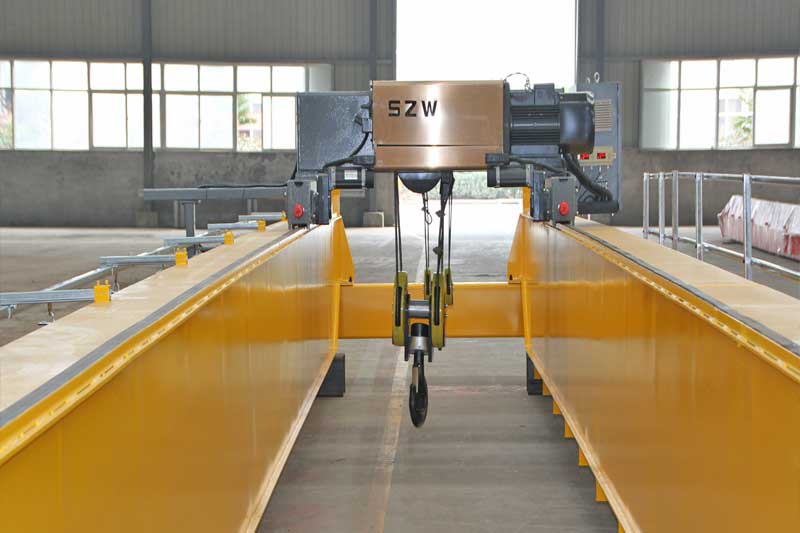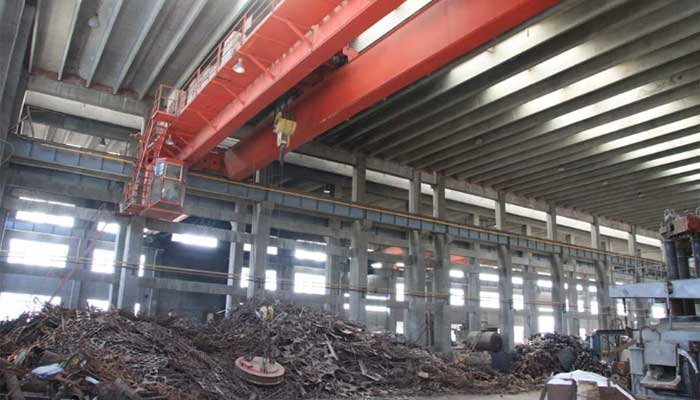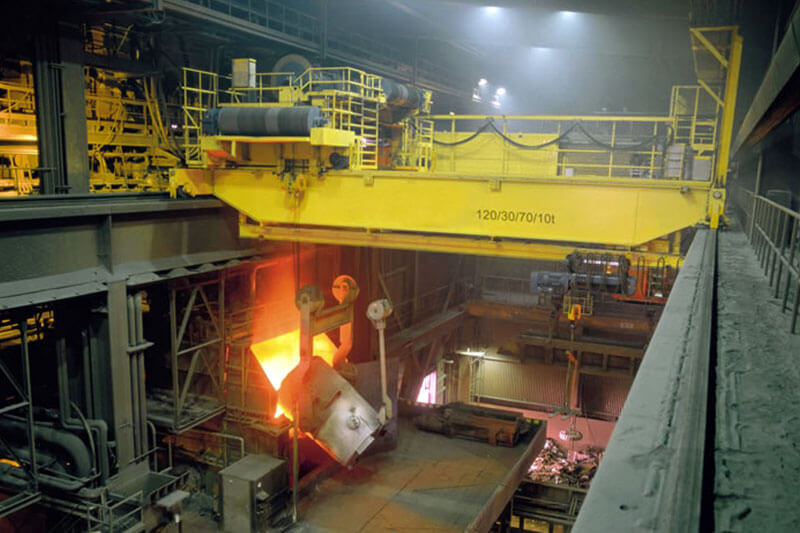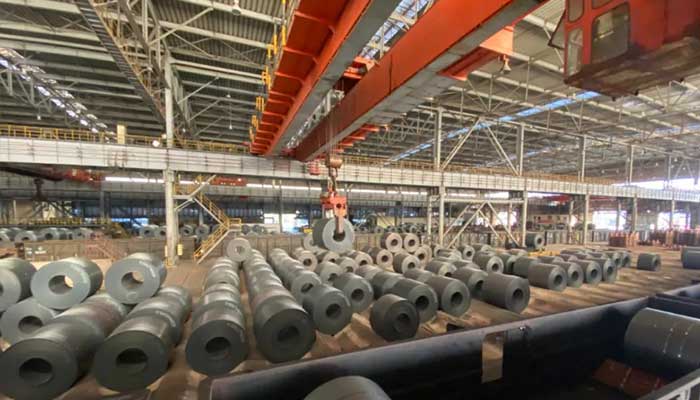3 Ton to 80 Ton Overhead Crane Operations in Ethiopia's Steel Industry
3 Ton to 80 Ton Overhead Crane Operations in Ethiopia's Steel Industry
The rhythmic clang of steel, the hum of machinery, and the towering structures of Ethiopia's steel industry tell a story of growth and industrial prowess. As this sector continues to expand, the role of overhead cranes becomes increasingly paramount. In this comprehensive guide, we delve into the intricacies of overhead crane operations, exploring their vital role in the diverse facets of Ethiopia's steel manufacturing landscape.
Ethiopia's steel industry stands at the forefront of the nation's industrial renaissance. Marked by an upsurge in production, the sector comprises a mosaic of steel foundries, metal fabrication shops, and sprawling steel manufacturing plants. This evolution is emblematic of Ethiopia's commitment to economic development and self-sufficiency.
At the heart of this steel symphony lies the silent yet powerful conductor – overhead cranes. These colossal machines are not mere tools but linchpins that orchestrate the seamless flow of raw materials, handle molten metal with precision, and elevate heavy steel components with ease. Understanding the significance of overhead cranes is pivotal to unlocking the full potential of Ethiopia's steel industry.
Ethiopian Steel Industrial Landscape
Types of Steel-Related Factories
Steel Foundries
In the realm of steel foundries, the alchemy of transforming raw materials into molten metal takes center stage. These foundries are crucibles of creativity and precision, where scrap metal finds new life as molten metal ready to be shaped into intricate components. Overhead cranes in this domain play a dual role, deftly handling raw materials and orchestrating the delicate dance of pouring molten metal into molds with unparalleled accuracy.
Metal Fabrication Shops
Metal fabrication shops are the workshops where steel metamorphoses into tangible structures. From structural beams to intricate components, these shops buzz with activity. Overhead cranes, especially double girder gantry cranes, prove instrumental in handling heavy metal components. Their robust design and lifting capabilities make them indispensable in the efficient movement of steel within these bustling fabrication hubs.
Steel Manufacturing Plants Steel manufacturing plants stand as the behemoths of the industry, where the alchemical processes of smelting and refining occur on a grand scale. These plants are the backbone of Ethiopia's steel production, requiring a sophisticated material handling approach. Here, a combination of single girder gantry cranes for raw material storage, monorail systems for continuous material flow, and double girder overhead cranes for heavy load lifting creates a symphony of efficiency.
Varied Scales and Locations across Ethiopia
The steel industry in Ethiopia is a tapestry woven with diversity in scales and geographical locations. From the bustling steel plants in Addis Ababa, the capital city, to the smaller but equally significant foundries in Dire Dawa and the fabrication shops dotting the landscape of Mek'ele, the industry spans the entire nation. Each location brings its unique challenges and opportunities, requiring a tailored approach to overhead crane operations.
In the next sections, we will delve into the specific applications of overhead cranes in these diverse settings, understanding how these mighty machines contribute to the vibrancy and growth of Ethiopia's steel industry. Stay with us as we unravel the stories hidden within each steel-related factory and explore the dynamic landscapes of Ethiopian steel manufacturing.
Applications of Overhead Cranes in Steel Foundries
Steel foundries, the crucibles of metallurgical innovation, demand precision and efficiency in material handling. Overhead cranes in these dynamic environments play a pivotal role in orchestrating the intricate processes from raw materials to the finished cast components.
Raw Material Handling
Efficient Movement of Scrap Metal
At the inception of the steel-making journey lies the raw material – scrap metal. Overhead cranes are the workhorses in efficiently handling and transporting these metallic remnants. Single girder gantry cranes, with their agility and versatility, deftly navigate through the foundry, collecting and transporting scrap metal to the furnaces. This efficient movement is the first step in the alchemical process that transforms discarded metal into the building blocks of the future.
Overhead crane with magnetic chuck for scrap metal handling
Molten Metal Handling
Specialized Foundry Cranes for Safe Handling
The transformation from solid to molten metal requires specialized handling to ensure both safety and precision. Foundry cranes engineered for this purpose come into play. Equipped with advanced features such as heat-resistant materials and precise controls, these cranes delicately transport ladles filled with molten metal from furnaces to molds. Their design prevents spillage and ensures the safe delivery of the molten metal, a critical step in the foundry's metallurgical ballet.

Ladle overhead crane for your reference
Finished Product Handling
Precise Positioning of Cast Metal Components
As the molten metal solidifies and takes shape within molds, overhead cranes step in for the final act – the handling of finished cast components. Whether it's large structural beams or intricate components, the versatility of overhead cranes comes to the fore. With features like adjustable speed and precise controls, these cranes delicately position the cast components, readying them for further processing or transport to the next stage of the steel manufacturing journey.
In the upcoming sections, we will unravel the role of overhead cranes in metal fabrication shops, exploring how these machines contribute to the creation of steel structures that form the backbone of Ethiopia's infrastructure. Join us as we delve deeper into the intricacies of steel manufacturing and the instrumental role played by overhead cranes in this dynamic industry.
Overhead Crane & Gantry Cranes Operations in Metal Fabrication Shops
Metal fabrication shops are bustling hubs of activity, where steel transforms from raw material into intricate components and structures. Overhead cranes play a crucial role in facilitating the various processes within these shops, from handling heavy metal components to ensuring precision in material movement.
Handling Heavy Metal Components
Utilization of Double Girder Gantry Cranes
In metal fabrication shops, heavy metal components are par for the course. Whether it's large structural beams or hefty machinery parts, the efficient handling of these components is essential for productivity and safety. Double girder gantry cranes, with their robust design and high lifting capacities, are the go-to solution for heavy-duty lifting tasks. Equipped with advanced features such as variable speed controls and precise positioning, these cranes ensure the smooth and safe movement of heavy metal components within the fabrication shop.
Steel Beam Handling
Specific Applications of Gantry Cranes
Steel beams form the backbone of many structures, and their fabrication requires specialized handling. Gantry cranes, with their versatility and adaptability, excel in this aspect. These cranes are equipped with features such as adjustable spans and precise controls, allowing for the efficient movement and positioning of steel beams during fabrication. Whether it's lifting beams onto welding tables or transporting them to storage areas, gantry cranes play a crucial role in streamlining the steel beam fabrication process.
Precision in Material Handling
Jib Cranes for Localized and Precise Movement
In addition to handling large and heavy components, metal fabrication shops often require precision in material movement for intricate tasks such as welding and assembly. Jib cranes, with their ability to provide localized lifting and precise positioning, are ideal for such applications. Mounted on walls or pillars, these cranes offer versatility and flexibility in material handling, allowing operators to maneuver components with ease and accuracy. Whether it's lifting small parts onto workstations or transporting materials between fabrication stations, jib cranes are indispensable tools in ensuring precision and efficiency in material handling within metal fabrication shops.
In the subsequent sections, we will explore the role of overhead cranes in steel manufacturing plants, examining their applications in handling raw materials, facilitating continuous material flow, and lifting heavy loads. Join us as we unravel the complexities of overhead crane operations in Ethiopia's steel industry.
Overhead Crane Applications in Steel Manufacturing Plants
Steel manufacturing plants, the giants of the industry, are vast landscapes where raw materials undergo a metamorphosis into the sturdy structures that form the backbone of Ethiopia's development. Overhead cranes in these plants are strategic allies, ensuring efficient raw material storage and retrieval, maintaining continuous material flow, and handling heavy loads with precision.
Raw Material Storage and Retrieval
Single Girder Gantry Cranes for Efficiency
Efficient storage and retrieval of steel raw materials are paramount in the grand tapestry of steel manufacturing plants. Single girder gantry cranes, with their agility and versatility, prove instrumental in this process. These cranes navigate through the expanse of raw material yards, lifting and transporting materials with efficiency. Their design allows for seamless movement, optimizing the storage and retrieval operations in the bustling environment of steel plant
Continuous Material Flow
Monorail Systems for Seamless Production Lines
Seamless material flow is a hallmark of well-designed steel manufacturing plants. Monorail systems, suspended from above, provide a continuous pathway for materials to traverse through various stages of production. These systems connect different workstations, ensuring a smooth and uninterrupted flow of raw materials and components. Overhead cranes equipped with monorail systems contribute to the synchronized dance of materials in the production line.
Heavy Load Lifting
Double Girder Overhead Cranes for Precision
In the realm of heavy-duty lifting, where large steel components take center stage, double girder overhead cranes are the undisputed champions. These cranes boast increased lifting capacity and height, making them ideal for handling massive steel structures. Whether it's lifting large beams destined for construction or transporting heavy components for further processing, these cranes ensure precision and reliability in the handling of substantial loads.
As we navigate through the various applications of overhead cranes in Ethiopia's steel industry, the subsequent section will shed light on location-specific considerations. Join us as we explore how overhead cranes adapt to the unique challenges posed by different regions, from the industrious Dire Dawa to the vibrant Mek'ele.
Location-Specific Considerations
In the diverse landscape of Ethiopia's steel industry, each location brings its own set of challenges and opportunities. From the industrious Dire Dawa to the vibrant Mek'ele and the bustling capital, Addis Ababa, location-specific considerations play a crucial role in shaping the requirements and applications of overhead cranes.
Dire Dawa: Steel Manufacturing Plants
Focus on Steel Manufacturing Plants and Specific Crane Requirements
Dire Dawa, with its strategic location and industrial significance, is home to steel manufacturing plants that form the industrial backbone of the region. Here, overhead cranes play a vital role in the processes of smelting, refining, and transforming raw materials into the sturdy structures that contribute to Ethiopia's growth. The specific crane requirements in Dire Dawa revolve around the efficient handling of raw materials, precise pouring of molten metal, and the seamless flow of materials in large-scale production lines.
Mek'ele: Steel Fabrication Shops
Highlighting Unique Aspects of Steel Fabrication Shops
Mek'ele, known for its dynamic growth and industrial development, features steel fabrication shops that contribute to the creation of structural components. The overhead cranes in Mek'ele are tailored for handling heavy metal components in fabrication processes, with a focus on precision and adaptability. The unique aspects of crane operations in Mek'ele include the intricate handling of steel beams, the creation of precise components, and the seamless coordination of material flow within the fabrication workshops.
Addis Ababa: Diverse Steel-Related Factories
Overview of Diverse Factories and Their Crane Needs
As the capital city, Addis Ababa stands as a melting pot of diverse industrial activities. The steel-related factories in Addis Ababa range from foundries to metal fabrication shops, each with its own crane needs. Overhead cranes in Addis Ababa must adapt to the varied scales and processes of these factories. Whether it's the efficient movement of scrap metal in foundries or the handling of diverse components in fabrication shops, the cranes in Addis Ababa are versatile and multifaceted.
Challenges and Solutions
In the dynamic landscape of Ethiopia's steel industry, challenges are inherent to the complex processes involved in transforming raw materials into sturdy structures. Overhead cranes, as indispensable tools in this journey, play a crucial role in addressing these challenges and providing innovative solutions to enhance efficiency and safety.
Addressing Challenges in Steel Industry Operations
Material Handling Complexity
The steel industry involves the handling of diverse materials, from scrap metal to molten steel and finished components. The challenge lies in efficiently managing this complexity, ensuring that each material is handled with precision and care. Overhead cranes equipped with specialized features, such as adjustable speed controls and heat-resistant materials, address the intricacies of material handling in various stages of steel production.
Continuous Workflow
Maintaining a continuous workflow is paramount in steel manufacturing. Interruptions or delays can have cascading effects on production timelines. Overhead cranes, especially those integrated with monorail systems, contribute to the seamless flow of materials in production lines. By connecting different workstations, these cranes ensure a continuous and uninterrupted workflow.
Crane Solutions for Improving Efficiency and Safety
Customization for Specific Industries
The diverse nature of steel-related factories requires overhead cranes that can be customized to meet specific industry needs. Crane manufacturers offer tailored solutions, adapting crane designs to the unique challenges posed by steel foundries, metal fabrication shops, and steel manufacturing plants. Customization ensures that each crane is optimized for its intended application, improving overall efficiency.
Integration of Smart Technologies
The infusion of smart technologies into overhead crane operations has revolutionized the steel industry. Remote monitoring capabilities allow for real-time tracking of crane performance, predictive maintenance, and enhanced safety features. This integration ensures that cranes operate at peak efficiency while providing insights into potential issues before they escalate.
As we conclude our journey through Ethiopia's steel industry and the pivotal role played by overhead cranes, the final section will encapsulate the essence of the guide. Join us for a recap of the applications, challenges, and solutions that define the symbiotic relationship between overhead cranes and Ethiopia's steel manufacturing landscape.
Compliance with Ethiopian Regulations
In the dynamic realm of Ethiopia's industrial landscape, adherence to local regulations is paramount to ensuring not only the efficiency of operations but, more importantly, the safety of the workforce and the surrounding environment. This holds true for overhead crane operations, where a comprehensive understanding of Ethiopian regulations is essential for maintaining compliance and promoting a culture of safety.
Understanding and Adhering to Local Regulations
Regulatory Landscape
Navigating the regulatory landscape in Ethiopia involves a thorough understanding of laws, standards, and guidelines set forth by relevant authorities. This encompasses regulations related to industrial operations, occupational safety, and specific guidelines for crane usage. Overhead crane operators and manufacturers must stay abreast of any updates or changes in these regulations to ensure ongoing compliance.
Occupational Safety Standards
Ethiopian regulations governing occupational safety are designed to safeguard the well-being of workers. This includes guidelines on crane operations, maintenance, and training programs. Ensuring that overhead crane operations align with these standards is crucial for creating a safe working environment and preventing accidents.
Ensuring Safety and Compliance in Crane Operations
Operator Training and Certification
Ethiopian regulations often emphasize the importance of trained and certified crane operators. Companies employing overhead cranes must invest in comprehensive training programs for operators, covering both theoretical knowledge and practical skills. Operator certification ensures that individuals entrusted with crane operations are well-equipped to handle the machinery safely and efficiently.
Routine Inspections and Maintenance
Regular inspections and maintenance are integral components of compliance. Ethiopian regulations may specify the frequency and thoroughness of crane inspections to identify and rectify any potential issues promptly. Establishing routine maintenance schedules ensures that cranes are in optimal working condition, reducing the risk of unexpected breakdowns and enhancing overall safety.
Documentation and Record-Keeping
Compliance extends to proper documentation and record-keeping. This includes maintaining records of inspections, maintenance activities, and operator certifications. Having a comprehensive and up-to-date documentation system facilitates regulatory audits and demonstrates a commitment to transparency and accountability in crane operations.
As we conclude our exploration of overhead crane operations in Ethiopia, the final section will encapsulate the key takeaways from this guide. Join us for a recap of the critical insights and considerations that define the effective and safe utilization of overhead cranes in Ethiopia's industrial landscape.
Custom Steel Mill Overhead Crane for Your Steel Mill Needs
As we conclude our comprehensive guide on the utilization of overhead cranes in Ethiopia's vibrant steel industries, it's imperative to recap the vital role these powerful machines play and glance toward future trends and developments that will shape crane technology and operations.
Overhead cranes stand as the backbone of Ethiopia's steel manufacturing, facilitating processes from raw material handling to the precise positioning of finished components. In steel foundries, fabrication shops, and manufacturing plants, these cranes contribute to efficiency, precision, and the seamless flow of materials.
From the industrious Dire Dawa to the dynamic Mek'ele and the diverse industrial landscape of Addis Ababa, overhead cranes adapt to location-specific challenges. Whether it's the specific requirements of steel manufacturing plants or the intricacies of fabrication workshops, cranes play a versatile role in shaping Ethiopia's steel industry in different regions.
Overhead cranes address challenges inherent in steel industry operations, providing solutions for material handling complexity, ensuring continuous workflow, and customizing operations for specific industries. The integration of smart technologies enhances efficiency, while adherence to Ethiopian regulations ensures safety and compliance in crane operations.
In concluding our exploration, we hope this guide has provided valuable insights into the integral role of overhead cranes in Ethiopia's steel industries. As the industry continues to evolve, so too will the technology and operations of these indispensable machines, shaping a future where efficiency, safety, and sustainability coexist seamlessly.




